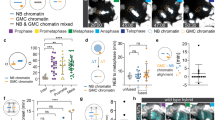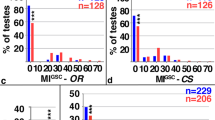Abstract
IT has been known for some time that factors in the cytoplasm of many eggs can influence the development of the cells, part of which they eventually constitute. This is most clearly seen in the case of the germ cell determinants. The removal of a particular region of the egg (the “pole plasm”) results in the absence of germ cells in the resulting animals1. We have begun an analysis of nuclear and cytoplasmic interactions in the egg of Drosophila melanogaster by means of nuclear transplantations. The advantages of Drosophila are its well described genetics and development; its disadvantages are the small size of the egg, its extreme sensitivity to minor damage to the egg membranes and the high turgor of the egg cell. Although nuclear transplantations in other animals have been fruitful2, two earlier attempts with Drosophila3,4 yielded a few differentiated larvae, but no adults. This was probably because injected eggs usually develop abnormalities which lead to early death of the embryo. We have tried to bypass this difficulty by culturing early embryonic stages in adult females and then causing them to metamorphose, a procedure developed independently by Hadorn et al.5 and Gateff and Schneiderman6. This made it possible to assess the developmental capacities of embryos from nuclear transplantations which underwent a great deal of development but would never have hatched.
This is a preview of subscription content, access via your institution
Access options
Subscribe to this journal
Receive 51 print issues and online access
$199.00 per year
only $3.90 per issue
Buy this article
- Purchase on Springer Link
- Instant access to full article PDF
Prices may be subject to local taxes which are calculated during checkout
Similar content being viewed by others
References
Gurdon, J. B., and Woodland, H. R., Biol. Rev., 43, 233 (1968).
Gurdon, J. B., Adv. Morphogenet., 4, 1 (1964).
Geyer-Duszynska, I., Rev. Suisse Zool., 74, 614 (1967).
Illmensee, K., Nature, 219, 1268 (1968).
Hadorn, E., Hürlimann, R., Mindek, G., Schubiger, G., and Staub, M., Rev. Suisse Zool., 75, 557 (1968).
Gateff, E., and Schneiderman, H. A., Nat. Cancer Inst. Monog., 31, 365 (1969).
Hadorn, E., Develop. Biol., 13, 424 (1966).
Author information
Authors and Affiliations
Rights and permissions
About this article
Cite this article
SCHUBIGER, M., SCHNEIDERMAN, H. Nuclear Transplantation in Drosophila melanogaster. Nature 230, 185–186 (1971). https://doi.org/10.1038/230185a0
Received:
Issue Date:
DOI: https://doi.org/10.1038/230185a0
This article is cited by
-
Remote-Sensing of Solar Wind Speeds from IPS Observations at 140 and 327 MHz Using MEXART and STEL
Solar Physics (2015)
-
From the Sun to the Earth: The 13 May 2005 Coronal Mass Ejection
Solar Physics (2010)
-
Carbon recombination lines from the Galactic plane at 34.5 & 328 MHz
Journal of Astrophysics and Astronomy (2001)
-
Hydrogen recombination lines near 327 MHz−II: A Galactic plane survey with a 2°×6′ beam
Journal of Astrophysics and Astronomy (2001)
-
Flux monitoring at 327 MHz during SL9-Jupiter collision
Journal of Astrophysics and Astronomy (1995)
Comments
By submitting a comment you agree to abide by our Terms and Community Guidelines. If you find something abusive or that does not comply with our terms or guidelines please flag it as inappropriate.



